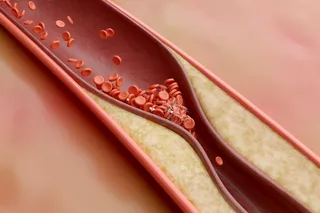"Notification," the radio crackled. "thirty-three-year-old female, status epilepticus. Down at her doctor's office. No response to Valium times two. Three minutes out." The nurses sprang to work preparing the medication cart, IV bags, and blood-drawing kit.
Status epilepticus can spell disaster. Unrelenting electrical discharges from neurons force a patient's limbs to contract and release without pause. The facial muscles twitch and contort, as if pummeled by a hail of invisible darts. The face turns a deep, impossible blue. While routine epileptic fits end within minutes, status epilepticus, left untreated, can go on for hours, destroying muscles and making neurons sizzle.
The patient, flanked by two perspiring paramedics, rolled in. Her arms and legs jerked rhythmically. Everyone in the emergency room clustered around.Mike, the other attending doctor on duty in the ER, took a look.
"Bit odd, huh?" he offered.
"What do you mean?" I asked.
"Pseudo-seizure?"
"No way. You can't fake this."
I studied our patient. With her contorted limbs and grimacing face, she seemed unconscious, lost in the brainstorm that envelops seizure sufferers. Mike shrugged. Angela, one of the residents, took up a position at the head of the bed. I quizzed her.
"Drug of choice?"
"Ativan," she responded.
"How much?"
"Push to eight milligrams," she replied. "Then reassess."
"Right."
Already I was contemplating what to do if the Ativan, a Valium-like drug that blocks excitatory connections among neurons, failed. This woman had already been seizing for at least 30 minutes. Unless we snuffed the lightning storm in her head within another 30 minutes, her overexcited brain cells would begin to die.
Angela pushed up the Ativan by two milligrams every two minutes. We hit eight milligrams, and still our patient was seizing.
"Time for Dilantin?" Angela asked.
Dilantin, used for more than 60 years, is the second-line drug for treating an unrelenting seizure. But it takes 20 minutes to give a full intravenous dose.
"Yes," I said. "Always anticipate."
The nurse hung the Dilantin IV. Angela increased the Ativan use to 15 milligrams. That amount is enough to knock a Clydesdale cold.
"Wow," I said, "she isn't stopping."
"Should we intubate?" Angela asked.
That would involve inserting a plastic breathing tube into the patient's windpipe. By ensuring an open airway, the tube would both protect her from choking vomit and allow us to give her third-line drugs like phenobarbital or Pentothal, which, when combined with Ativan, can stop a patient's breathing. But to get past her clenching jaw, we would have to paralyze her with curarelike drugs. And once we stilled her muscle contractions, the only way to tell whether she was still frying her neurons would be to read her brain waves with an electroencephalograph, which we did not have. We would have a patient hurtling toward brain injury and no way to tell what treatment was working.
"Intubation set," Angela ordered. The nurse handed her the equipment. At that moment, the patient opened her eyes, took in the ER team, and to our collective astonishment, said, "Could I have some water, please?"
True seizures always leave a patient disoriented and uncomprehending. This postseizure state, as much a part of epilepsy as wings on a butterfly, lasts minutes to hours, never seconds. Never.
I gaped at Angela. The look on her face said it all: pseudo-seizure. We had been snookered.
Epilepsy afflicts about 1 percent of the population and remains, in its own right, a mystery. No one knows why some neurons, in response to a tumor, an old injury, or nothing that we can discern, fire so violently that they recruit the rest of the brain into a muscle-whipping frenzy. Even more mysterious is how— or why— someone would simulate a seizure.
Yet pseudo-seizures are not rare. A few months after I saw this patient, another young woman arrived in the emergency room.
"She dropped on the subway platform," said the lead medic breathlessly. "Been seizing about half an hour now."
I studied her. Her head seemed cocked a little theatrically, her wrists pulled into too-rounded a fetal curl, and her clenched eyelids too willfully closed. I pronounced her a fraud.
"But she's seizing," the ambulance crew insisted.
"Watch," I said, picking up her left arm and letting it drop over her face. The arm jerked away without hitting her. "She's conscious," I told them.
We found her mother's telephone number and gave her a call.
"Please," she urged us, "my daughter's seizures are psychological. Don't give her anticonvulsant medications."
Even epilepsy experts witnessing a seizure sometimes have a hard time telling the true from the false. And given that the seizures are so unpredictable and infrequent, doctors are often forced to rely on the descriptions of bystanders or family members to make a diagnosis. All of this makes diagnosing pseudo-seizures one of the most vexing dilemmas in clinical medicine.
To sort out real seizures from pseudo-seizures, many hospitals have set up wards equipped with sophisticated monitoring systems. First, they use electroencephalographs, instruments that provide a continuous report of the brain's electrical activity. Second, they use a 24-hour video camera. While the patient is under observation, doctors try to provoke a seizure. The most reliable techniques involve depriving patients of sleep and exposing them to very fast strobe lights. It's no picnic. Days or weeks may pass before a genuine seizure shows up.
Since virtually all seizures generate abnormal brain waves on a reading called an electroencephalogram, or EEG, a seizure unaccompanied by EEG abnormalities is, with rare exceptions, a pseudo-seizure. Researchers using this monitoring technique have found that from one fifth to one third of the patients sent for evaluation for epilepsy lack evidence of seizure in the brain. And strangely enough, about one tenth of the patients with proven epilepsy also manifest pseudo-seizures.
They should not, however, be dismissed as grandstanding. The majority of cases, it turns out, spring from unresolved psychological conflicts, usually the result of physical or sexual abuse. The patient whose seizure had fooled us, for example, was in the midst of a divorce, and the nurses said she'd also described a history of sexual abuse. Seen from that perspective, a pseudo-seizure becomes less a ploy for attention than a magical catapult out of reality. So involuntary do the seizures feel that patients are surprised when monitoring shows they don't suffer from epilepsy. Psychotherapy can offer them real hope of relief.
The diagnosis can also bring surprising self-knowledge. One of my patients, an intelligent woman in her late forties, was open, witty, and knowledgeable about her condition. After years of drug treatment punctuated by periodic breakthrough seizures, she underwent monitoring. The workup showed that about half of her seizures had no basis in the brain. After that, the pseudo-seizures abated, and the real seizures were easily controlled by adjusting her medications. Fascinated, I asked her what it feels like when a pseudo-seizure strikes.
"You don't really control them," she explained. "They would hit me on the cafeteria line. On the bus. Wherever. Maybe it was my way of letting stress out. But you really can't tell if it's you or your brain acting up."Then she smiled. "And you know what? I had a hard time letting them go. They'd become— you're going to think I'm nuts— a part of me."

"Pseudoneurologic Syndromes: Recognition and Diagnosis," Aziz Shaibani and Marvin N. Sabbagh, American Family Physician, May 15, 1998, describes a collection of psychosomatic ailments including pseudo-seizures. Find it on the American Family Physician Web site at www.aafp.org/afp.














